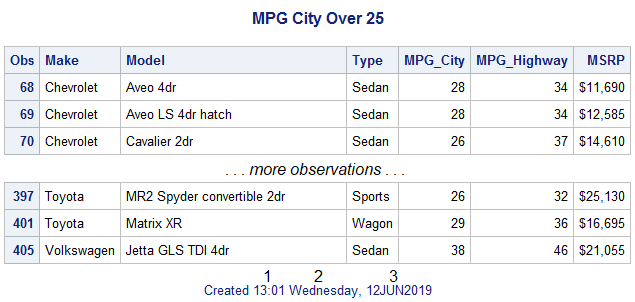Using Macro Variables
Using User-Defined Macro Variables
%LET Statement Syntax
Use the %LET statement to define your macro variable
and assign a value to it.
|
Syntax, %LET statement:
%LET variable=value;
variable
is any name that follows
the SAS naming convention.
value
can be any string from
0 to 65,534 characters long.
|
Note: If the variable already exists,
then the value replaces the current value. If either variable or value
contains a reference to another macro variable (such as
&macvar),
the reference is evaluated before the assignment is made.Using Automatic Macro Variables
What Are Automatic Macro Variables?
SAS creates and defines several automatic
macro variables for you. Automatic macro variables contain information
about your computing environment, such as the date and time of the
session, and the version of SAS that you are running. Keep the following
facts in mind about these automatic macro variables:
-
They are created when SAS starts.
-
They are global (always available).
-
They are usually assigned values by SAS.
-
They can be assigned values by the user in some cases.
Some automatic macro
variables have fixed values that are set when SAS starts.
|
Name
|
Value
|
|---|---|
SYSDATE |
the date of the SAS
invocation (DATE7.)
|
SYSDATE9 |
the date of the SAS
invocation (DATE9.)
|
SYSDAY |
the day of the week
of the SAS invocation
|
SYSTIME |
the time of the SAS
invocation
|
SYSENV |
FORE (interactive execution)
or BACK (noninteractive or batch execution)
|
SYSSCP |
an abbreviation for
the operating system that is being used, such as WIN or LINUX
|
SYSVER |
the release of SAS that
is being used
|
SYSJOBID |
an identifier for the
current SAS session or for the current batch job (the user ID or job
name for mainframe systems, the process ID (PID) for other systems)
|
Some automatic macro
variables have values that automatically change based on submitted
SAS statements.
|
Name
|
Value
|
|---|---|
SYSLAST |
the name of the most
recently created SAS data set, in the form
LIBREF.NAME.
This value is always stored in all capital letters. If no data set
has been created, the value is _NULL_. |
SYSPARM |
text that is specified
when SAS starts.
|
SYSERR |
contains a return code
status that is set by the DATA step and some SAS procedures to indicate
whether the step or procedure executed successfully.
|
Example: Using Automatic Macro Variables
You can substitute system
information such as the time, day, and date on which your SAS session
started in footnotes for a report.
footnote1 "Created &systime &sysday, &sysdate9"; title "MPG City Over 25"; proc print data=sashelp.cars; var Make Model Type MPG_City MPG_Highway MSRP; where MPG_City>25; run;
Output 7.1 PROC PRINT Output of Automatic Macro Variables

| 1 | time of day (SYSTIME) |
| 2 | day of the week (SYSDAY) |
| 3 | date (day, month, and year) (SYSDATE9) |
Last updated: October 16, 2019
..................Content has been hidden....................
You can't read the all page of ebook, please click here login for view all page.
